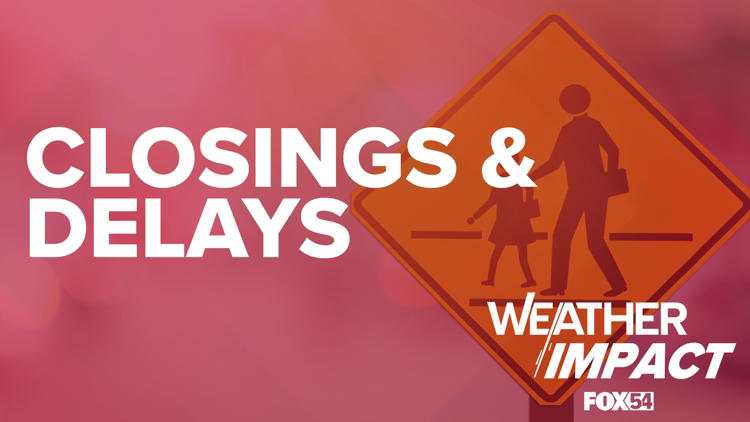Winter Weather Advisory: How School Delays & Closings Are Decided

Table of Contents
Factors Influencing School Closure Decisions
Numerous elements are carefully weighed before a school district announces a closing or delay due to inclement weather. These decisions are never taken lightly and prioritize the safety and well-being of everyone involved.
Road Conditions
Dangerous road conditions are a primary concern when considering school closings due to winter weather. Icy patches, heavy snow accumulation, and reduced visibility significantly impact the safety of student and staff commutes.
- Impact on bus routes: Icy or snow-covered roads make bus routes treacherous, increasing the risk of accidents. Bus drivers need safe and manageable conditions to navigate their routes effectively.
- Student and staff commutes: The safety of students and staff traveling to and from school is paramount. Impassable roads or hazardous driving conditions can put individuals at risk.
- Emergency vehicle access: School districts must ensure that emergency vehicles can access school buildings in case of unforeseen incidents. Blocked roads can hinder timely response in emergencies.
School districts use various tools to assess road conditions, including:
- Real-time weather reports from the National Weather Service and local meteorological agencies.
- Direct feedback and reports from road crews and transportation staff who are actively monitoring road conditions throughout the district.
Weather Forecasts & Warnings
School districts heavily rely on meteorological data to inform their decisions regarding school closings due to winter weather. This includes:
- Temperature: Extremely low temperatures, especially when combined with wind chill, pose a serious risk to students waiting at bus stops or participating in outdoor activities.
- Precipitation type and amount: The type of precipitation (snow, sleet, freezing rain) and its accumulation rate directly affect road conditions and the potential for hazardous travel.
- Wind chill: Wind chill significantly lowers the perceived temperature, increasing the risk of hypothermia for students and staff.
- Timing of the storm: The duration and intensity of the storm influence the decision-making process. A brief, intense snowstorm might lead to a delay, while a prolonged event might necessitate a closure.
School districts utilize various sources for weather data, including:
- The National Weather Service (NWS): The NWS provides official weather forecasts, warnings (like Winter Storm Warnings and Winter Weather Advisories), and advisories, offering crucial information about the severity and timing of winter storms. It is crucial to understand the difference between a Watch (conditions are favorable for severe weather) and a Warning (severe weather is imminent or occurring).
- Local news channels and weather websites: These provide real-time updates and localized weather information.
Temperature Extremes
Dangerously low temperatures, especially with wind chill, are a major factor in school closing decisions relating to School Closings Winter Weather. Exposure to extreme cold can be particularly harmful to vulnerable student populations:
- Young children: Their smaller body mass makes them more susceptible to hypothermia.
- Students with health conditions: Certain medical conditions increase vulnerability to cold weather.
School districts often use specific temperature thresholds (often including wind chill) to determine whether conditions are dangerously low. These thresholds can vary based on local climate and the district’s specific risk assessment.
The Decision-Making Process
The decision to close schools due to inclement weather is a careful and collaborative process.
Collaboration & Communication
School districts work closely with multiple entities to make informed decisions:
- Local authorities (police, fire departments, transportation departments): Collaboration ensures a comprehensive understanding of road conditions and potential safety risks.
- Communication channels: These include website updates, email alerts, social media posts, and announcements through local news outlets to reach parents and the community.
Internal decision-making involves:
- Meetings with administrators, transportation staff, and safety personnel.
- Internal decision-making committees that assess all available data before a final decision is made.
Timing of Announcements
Making timely announcements is crucial, balancing accuracy with providing sufficient warning. However, this presents challenges:
- Typical announcement times: Announcements are often made the night before or very early in the morning, depending on the predicted timing of the storm.
- Factors influencing announcement timing: The intensity of the storm and evolving weather conditions can necessitate adjustments to the announcement timeline.
Transparency & Communication Strategies
Clear and consistent communication is vital. School districts utilize various methods:
- Multiple communication channels (website, email, social media, etc.)
- Consistent messaging across all channels
- Proactive communication to anticipate potential questions and concerns.
Addressing parent concerns and providing ample opportunity for questions is crucial for building trust and ensuring the community feels informed.
Alternative Learning Options
In the age of technology, school districts are increasingly employing alternative methods to ensure continued learning during winter weather closures.
Remote Learning
Online learning platforms have become a viable option:
- Benefits: Allows students to continue learning despite school closures.
- Challenges: Requires reliable internet access and technological proficiency for all students, posing equity concerns for those without it.
Make-Up Days/Extended School Year
Missed instructional time due to weather necessitates solutions:
- State regulations: Many states have regulations regarding the minimum number of instructional days required.
- Strategies for making up lost time: Schools may add days to the end of the year, utilize snow days built into the calendar, or employ other strategies to meet the required instructional time.
Conclusion
School closings and delays due to winter weather are serious decisions with wide-ranging implications. Understanding the complex interplay of road conditions, weather forecasts, temperature extremes, and communication strategies is vital for appreciating the challenges faced by school administrators. By being aware of the factors that contribute to these decisions, parents and the community can better prepare for winter weather events. Stay informed about your school district's policies and communication channels concerning School Closings Winter Weather to ensure a smoother and safer experience for everyone. Knowing how your local school district handles winter weather closures empowers you to prepare effectively and minimizes disruption.

Featured Posts
-
 Eurovision 2025 Finalists A Ranking From Hypnotic To Atrocious
May 20, 2025
Eurovision 2025 Finalists A Ranking From Hypnotic To Atrocious
May 20, 2025 -
 March 8 Nyt Mini Crossword Solutions
May 20, 2025
March 8 Nyt Mini Crossword Solutions
May 20, 2025 -
 Huuhkajien Avauskokoonpanossa Kolme Yllaetystae Kaellman Sivussa
May 20, 2025
Huuhkajien Avauskokoonpanossa Kolme Yllaetystae Kaellman Sivussa
May 20, 2025 -
 The Great Migration Americans Seeking European Citizenship To Escape Political Climate
May 20, 2025
The Great Migration Americans Seeking European Citizenship To Escape Political Climate
May 20, 2025 -
 April 18th 2025 Nyt Mini Crossword Answers And Solution Hints
May 20, 2025
April 18th 2025 Nyt Mini Crossword Answers And Solution Hints
May 20, 2025
